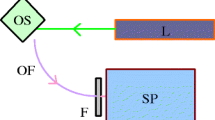Abstract
The present review describes chemiluminescence applications to olive oil analysis and olive mill wastewater and covers the literature published in recent years. The article has been divided into several sections that discuss specific applications for determining phenolic compounds, antioxidant activity, radical scavenging, oxidative stability and the detection of possible adulteration by seed oils. The advantages and disadvantages of the chemiluminescence detection systems for these purposes are evaluated.



Similar content being viewed by others
References
Consensus report, Jaen (Spain) 2004 (2005) International conference on the healthy effect of virgin olive oil. Eur J Clin Invest 35:421–424
D’Angelo S, Manna C, Migliardi V, Mazzoni O, Morrica P, Capasso G, Pontoni G, Galleti P, Zappia V (2001) Pharmacokinetics and metabolism of hydroxytyrosol, a natural antioxidant from olive oil. Drug Metab Dispos 29:1492–1498
Visioli F, Poli A, Galli C (2002) Antioxidant and other biological activities of phenols from olives and olive oil. Med Res Rev 22:65–75
Vissers MN, Zock PL, Katan MB (2004) Bioavailability and antioxidant effects of olive oil phenols in humans: a review. Eur J Clin Nutr 58:955–965
Carrasco-Pancorbo A, Cerretani L, Bendini A, Segura-Carretero A, Gallina-Toschi T, Fernández-Gutierrez A (2005) Analytical determination of polyphenols in olive oils. J Sep Sci 28:837–858
Carrasco Pancorbo A, Cruces Blanco C, Segura Carretero A, Fernández Gutierrez A (2004) Sensitive determination of phenolic acids in extra-virgin olive oil by capillary zone electrophoresis. J Agric Food Chem 52:6687–6693
Hrncirik K, Fritsche S (2004) Comparability and reliability of different techniques for the determination of phenolic compounds in virgin olive oil. Eur J Lipid Sci Technol 106:540–549
Tasioula-Margari M, Okogeri O (2001) Isolation and characterization of virgin olive-oil phenolic compounds by HPLC/UV and GC-MS. J Food Sci 66:530–534
Galliana-Toschi T, Cerretani L, Bendini A, Bonoli-Carbognin M, Lercker G (2005) Oxidative stability and phenolic content of virgin olive oil: An analytical approach by traditional and high resolution techniques. J Sep Sci 28:859–870
García-Campaña AM, Baeyens WRG (2000) Principles and recent analytical applications of chemiluminescence. Analusis 28:686–698
Chasteen, T G Analytical Chemiluminescence http://www.photobiology.com/educational/anchem.htm
de Jong G, Kwakman JM (1989) Chemiluminescence detection for High-Performance Liquid Chromatography of biomedical samples. J Chromatogr 492:319–343
Triantis T, Papadopoulos K, Stellakis A, Dimotikali D (2004) Studies on the antioxidant activity of aqueous extracts of olive oils and seed oils using chemiluminescence. Chem Phys Lipids 130:57–57
de la Puerta R, Ruiz Gutierrez V, Hoult JRS (1999) Inhibition of leukocyte 5-lipoxygenase by phenolics from virgin olive oil. Biochem Pharmacol 57:445–449
Papadopoulos K, Triantis T, Yannakopoulos E, Nikokavoura A, Dimotikali D (2003) Comparative studies on the antioxidant activity of aqueous extracts of olive oils and seed oils using chemiluminescence. Anal Chim Acta 494:41–47
Chasteen T G The chemiluminescence of luminol and bis(2,4,6-trichlorphenyl)oxalate (TCPO). http://www.shsu.edu/∼chm_tgc/JPPdir/JPP1999/
Miyazawa T, Saeki R, Inaba H (2005) Detection of chemiluminecence in lipid peroxidation of biological systems and its application to HPLC. J Biolumin Chemilumin 4:475–478
Atanassova D, Kefalas P, Psillakis E (2005) Measuring the antioxidant activity of olive oil mill wastewater using chemiluminescence. Environ Int 31:275–280
Roginsky V, Lissi EA (2005) Review of methods to determine chain-breaking antioxidant activity in food. Food Chem 92:235–254
Miyazawa T, Kunika H, Fujimoto K, Endo Y, Kaneda T (1995) Chemiluminescence detection of mono-, bis, and trishydroperoxy triacylglycerols present in vegetable oils. Lipids 30:1001–1006
Sawa T, Akaike T, Kida K, Fukushima Y, Takagi K, Maeda H (1998) Lipid peroxyl radicals from oxidized oils and heme-iron: Implication of high-fat diet in colon carcinogenesis. Cancer Epidem Biomar 7:1007–1012
Visioli F, Bellomo G, Galli C (1998) Free radical-scavenging properties of olive oil polyphenols. Biochem Biophys Res Co 247:60–64
Yu Y-M, Tsai CE (2003) LDL cholesterol and oxidation are significantly reduced in type 2 diabetic patients receiving a barley leaf essence supplemented olive oil diet. Food Sci Agric Chem 5:1–6
Iftimie N, Herdan JM, Giurginca M, Meghea A (2004) Chemiluminescence technique for evaluation of thermooxidative stability of some mineral and vegetable oils protected by antioxidants. Rev Chim Bucharest 55:512–513
O’Dowd Y, Driss F, My-Chan Dang P, Elbim C, Gougerot-Pocidalo MA, Pasquier C, El-Benna J (2004) Antioxidant effect of hydroxytyrosol, a polyphenol from olive oil: scavenging of hydrogen peroxide but not superoxide anion produced by human neutrophils. Biochem Pharmacol 68:2003–2008
Atanassova D, Kefalas P, Petrakis C, Mantzavinos D, Kalogerakis N, Psillakis E (2005) Sonochemical reduction of the antioxidant activity of olive mill wastewater. Environ Int 31:281–287
Buenestado A, Cortijo J, Sanz MJ, Naim-Abu-Nabah Y, Martinez-Losa M, Mata M, Issekutz AC, Martí-Bonmatí E, Morcillo EJ (2006) Olive oil-based lipid emulsion’s neutral effects on neutrophil functions and leukocyte-endothelial cell interactions. JPEN Parenter Enter 30:286–296
Stepanyan V, Arnous A, Petrakis C, Kefalas P, Calokerinos A (2005) Chemiluminescent evaluation of peroxide value in olive oil. Talanta 65:1056–1058
Ruiz Gutierrez V, de la Puerta R, Catalá A (2001) The effect of tyrosol, hydroxytyrosol and oleuropein on the non-enzymatic lipid peroxidation of rat liver microsomes. Mol Cell Biochem 217:35–41
Papadopoulos K, Triantis T, Tzikis CH, Nikokavoura A, Dimotikali D (2002) Investigations of the adulteration of extra virgin olive oils with seed oils using their weak chemiluminescence. Anal Chim Acta 464:135–140
Kruk I, Aboul-Enein HY, Michalska T, Lichszteld K, Ktadna A (2005) Scavenging of reactive oxygen species by the plant phenols genistein and oleuropein. Luminescence 20:81–89
Author information
Authors and Affiliations
Corresponding author
About this article
Cite this article
Navas, M.J., Jiménez, A.M. Chemiluminescent Methods in Olive Oil Analysis. J Amer Oil Chem Soc 84, 405–411 (2007). https://doi.org/10.1007/s11746-007-1061-5
Received:
Revised:
Accepted:
Published:
Issue Date:
DOI: https://doi.org/10.1007/s11746-007-1061-5




